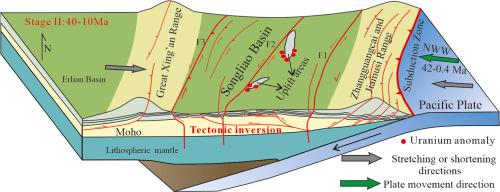当前位置:
X-MOL 学术
›
Gondwana Res.
›
论文详情
Our official English website, www.x-mol.net, welcomes your feedback! (Note: you will need to create a separate account there.)
Regional sandstone-type uranium mineralization rooted in Oligo–Miocene tectonic inversion in the Songliao Basin, NE China
Gondwana Research ( IF 6.1 ) Pub Date : 2020-12-01 , DOI: 10.1016/j.gr.2020.08.002 Yinhang Cheng , Shaoyi Wang , Tianfu Zhang , Xueming Teng , Cong Ao , Ruoshi Jin , Hongliang Li
Gondwana Research ( IF 6.1 ) Pub Date : 2020-12-01 , DOI: 10.1016/j.gr.2020.08.002 Yinhang Cheng , Shaoyi Wang , Tianfu Zhang , Xueming Teng , Cong Ao , Ruoshi Jin , Hongliang Li

|
Abstract The tectonic inversion of the Songliao Basin during the Oligo–Miocene may have played an important role in controlling the development of sandstone-type uranium deposits (SUDs). Here we investigate drill holes along a southeast to northwest section in this basin based on apatite fission-track (AFT) and zircon fission-track (ZFT) techniques. We present 50 data from 15 deep boreholes at different depths between 665 and 3956 m and different structural units including grabens and horsts formed in the Early Cretaceous beneath the basin. The results of the effective AFT ages are 100 ± 11 to 2.3 ± 0.4 Ma (P(x2) > 5%) and ZFT ages are 97.5–20.4 Ma (including binomial peak ages). These results reveal that the basin underwent two distinct stages of rapid cooling after Late Cretaceous. In the first stage, during the Late Cretaceous–Early Paleogene (~80–50 Ma), tectonic uplift occurred in all of the structural units including grabens and horsts, which was marked by an unconformity between the latest Cretaceous Mingshui and the Eocene Yi'an formations. In the second stage, during the Oligo–Miocene (~40–10 Ma), tectonic uplift occurred mainly in the grabens but not in the horsts, corresponding with a few sediments of the Neogene Da'an and Taikang formations. We propose that the folds and the thrust faults mostly characterize in the second stage indicating a major tectonic inversion in the basin. The shifting of the two stages was probably in response to differences in the subduction angles and directions of motion of the Paleo-Pacific Plate from the southeast. Combined with previous information, it was demonstrated that most of the U mineralization ages are younger than 40 Ma, with a peak in the Miocene or later (
更新日期:2020-12-01


























 京公网安备 11010802027423号
京公网安备 11010802027423号